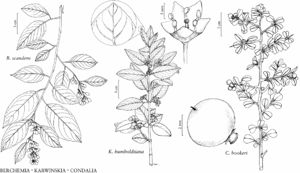Condalia
Anales Hist. Nat. 1: 39, plate 4. 1799.
| Taxon | Illustrator ⠉ | |
|---|---|---|
 | Condalia hookeri Berchemia scandens Karwinskia humboldtiana | Yevonn Wilson-Ramsey Yevonn Wilson-Ramsey Yevonn Wilson-Ramsey |
Shrubs or small trees, usually armed with thorns, sometimes unarmed; bud-scales absent. Leaves deciduous, alternate, mostly borne on short-shoots and usually fascicled; blade not gland-dotted; pinnately veined. Inflorescences axillary, within foliage, fascicles or flowers solitary; peduncles and pedicels not fleshy in fruit. Pedicels present or absent. Flowers bisexual; hypanthium hemispheric, 1–1.5 mm wide; sepals 5, spreading, greenish abaxially, yellowish adaxially, deltate, keeled adaxially; petals 0 (5, yellow, hooded, spatulate, short-clawed in C. ericoides); nectary absent, thin, or margin thickened, lining hypanthium; stamens 5; ovary superior, 2-locular at least early in development, 1 locule often suppressed; style 1. Fruits drupes; stone 1, indehiscent.
Distribution
w United States, Mexico, Central America, South America
Discussion
Species 18 (7 in the flora).
A close relationship between Condalia and Ziziphus might be inferred from numerous synonyms of one genus within the other—drupaceous fruits are produced in both genera. However, the closest relatives of Condalia appear to be Karwinskia and Rhamnidium Reissek (J. E. Richardson et al. 2000) of Central America, South America, and the West Indies, and only slightly more distantly, Berchemia, Rhamnus, and Sageretia.
Selected References
Lower Taxa
Key
| 1 | Leaf blades linear; petals 5. | Condalia ericoides |
| 1 | Leaf blades spatulate to obovate or elliptic; petals 0. | > 2 |
| 2 | Leaf blades spatulate to spatulate-elliptic, venation conspicuous abaxially. | > 3 |
| 3 | Leaf blade surfaces glabrous, abaxial intervein surfaces with rounded transverse ridges, surface appearing as if molded in wax; branches glabrous. | Condalia spathulata |
| 3 | Leaf blade surfaces hispidulous, puberulent, or densely short-villous to velutinous, abaxial intervein surfaces microvesiculate, not appearing waxy; branches hispidulous or densely short-villous to velutinous. | > 4 |
| 4 | Pedicels 2.5–4.5(–6.5) mm; internodes 2–7 mm; sepals deciduous in fruit; leaf blade apices obtuse to mucronate. | Condalia globosa |
| 4 | Pedicels 0.5–3 mm; internodes 0.5–2(–3) mm; sepals persistent in fruit; leaf blade apices acute. | Condalia warnockii |
| 2 | Leaf blades obovate to elliptic or elliptic-oblong, venation inconspicuous abaxially. | > 5 |
| 5 | Leaf blades (10–)15–20(–31) × (5–)9–12(–19) mm, apices on a single plant consistently rounded to truncate-emarginate. | Condalia hookeri |
| 5 | Leaf blades 5–11(–21) × 2.5–6(–10) mm, apices on a single plant acute to rounded, truncate, or emarginate. | > 6 |
| 6 | Secondary branches sparsely hispidulous or glabrate; petioles 3–10 mm; drupes 5–6 mm. | Condalia viridis |
| 6 | Secondary branches densely hispidulous; petioles 1–3 mm; drupes 8 mm. | Condalia correllii |